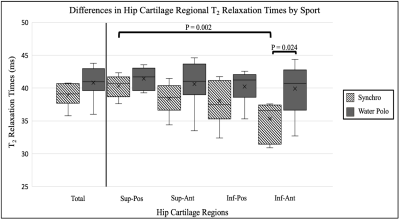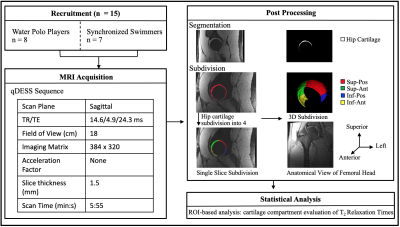Elka B Rubin1, Joanna L Langner2, Marianne S Black2, Arjun D Desai2, James W MacKay3, Carly Jones4, Kimberly E Hall2, Marc R Safran2, Feliks Kogan2, and Garry E Gold2
1Radiology, Stanford University, Stanford, CA, United States, 2Stanford University, Stanford, CA, United States, 3Radiology, Cambridge University, Cambridge, United Kingdom, 4Centre for Hip Health and Mobility, University of British Columbia, Vancouver, BC, Canada
1Radiology, Stanford University, Stanford, CA, United States, 2Stanford University, Stanford, CA, United States, 3Radiology, Cambridge University, Cambridge, United Kingdom, 4Centre for Hip Health and Mobility, University of British Columbia, Vancouver, BC, Canada
This work demonstrates that quantitative MRI can detect regional differences in the hip cartilage of female water polo players and synchronized swimmers; this suggests possible regional differences in cartilage matrix composition between these two groups.

Figure 3: The average T2 Relaxation Times for synchronized swimmers (synchro) and water polo players (water polo) across the total hip cartilage and four subregions: superior-posterior (sup-pos), superior-anterior (sup-ant), inferior-posterior (inf-pos), and inferior-anterior (inf-ant). The average T2 relaxation time means are more stable in water polo players and have more variability in the synchronized swimmers.
